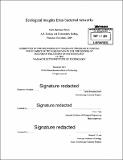Ecological insights from bacterial networks
Author(s)
Smith, Mark Burnham
DownloadFull printable version (11.64Mb)
Other Contributors
Massachusetts Institute of Technology. Department of Biology.
Advisor
Eric J. Alm.
Terms of use
Metadata
Show full item recordAbstract
Microbes occupy a wide range of important niches ranging from global biogeochemical cycles to metabolism in the human gut. Yet microbes rarely act in isolation. Instead, they thrive in complex communities with myriad combinatorial interactions. In this work I explore the nature of these bacterial networks, using computational tools to uncover ecological associations with relevance to both human health and environmental restoration. I begin with the discovery of a massive, global network of recent gene exchange linking even distantly related bacteria from the far corners of earth. To uncover this network, I developed and validated a simple evolutionary rate heuristic and applied it to report recent transfers across nearly 5 million pairwise interactions among bacterial genomes. I interrogated this network for associations between rates of horizontal gene transfer (HGT) and differences in the geography, ecology and phylogenetic history of each pair of genomes. Of these influences, ecological overlap is the most important force shaping recent gene exchange. In the second chapter, I use CRISPR arrays as a record of recent infections to investigate the host range of mobile genetic elements. I report 7,009 pairs of genomes that contain identical spacers and are at least 10% divergent at the 16S rRNA gene, implying an overlap in genetic element host range. This provides a mechanistic framework to understand the transfers uncovered in the first chapter. In the final section of this work, I exploit this powerful link between bacterial communities and their environments to create a machine-I earning algorithm that translates DNA from natural bacterial communities into accurate, quantitative readouts of environmental conditions. I develop this approach using 16S rRNA sequence data from 93 groundwater wells in Oak Ridge, Tennessee to predict a diverse array of 26 geochemical measurements. I validate this technique using microarray data from the Deepwater Horizon oil spill. The predictive power of these models generally emerges from the composite of the entire community and its interactions, rather than from a single strain. As a whole, this body of work demonstrates the profound connections that link the microbial world into an ecologically structured network.
Description
Thesis: Ph. D., Massachusetts Institute of Technology, Department of Biology, 2014. Cataloged from PDF version of thesis. Includes bibliographical references (pages 93-101).
Date issued
2014Department
Massachusetts Institute of Technology. Department of BiologyPublisher
Massachusetts Institute of Technology
Keywords
Biology.